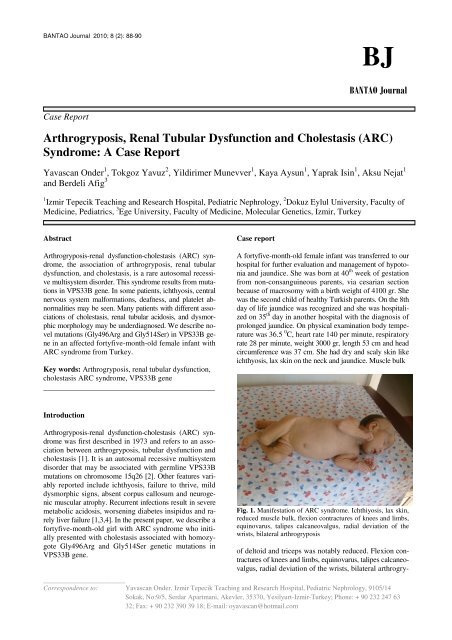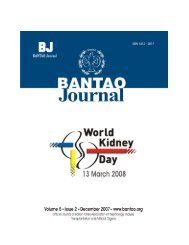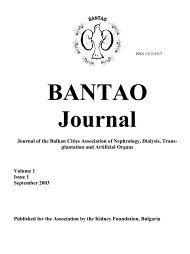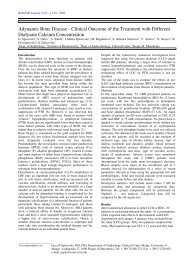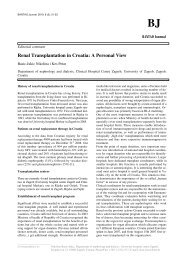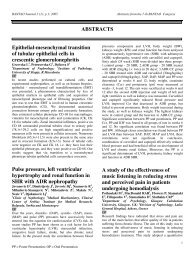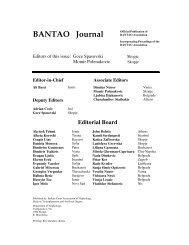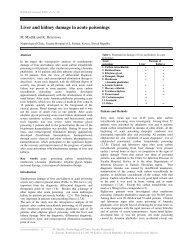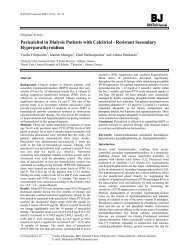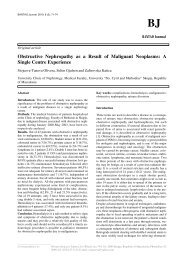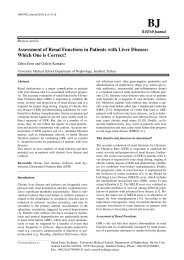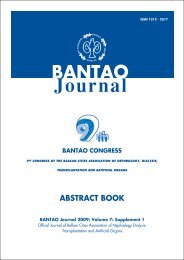(ARC) Syndrome: A Case Report - BANTAO Journal
(ARC) Syndrome: A Case Report - BANTAO Journal
(ARC) Syndrome: A Case Report - BANTAO Journal
- No tags were found...
You also want an ePaper? Increase the reach of your titles
YUMPU automatically turns print PDFs into web optimized ePapers that Google loves.
<strong>BANTAO</strong> <strong>Journal</strong> 2010; 8 (2): 88-90BJ<strong>BANTAO</strong> <strong>Journal</strong><strong>Case</strong> <strong>Report</strong>Arthrogryposis, Renal Tubular Dysfunction and Cholestasis (<strong>ARC</strong>)<strong>Syndrome</strong>: A <strong>Case</strong> <strong>Report</strong>Yavascan Onder 1 , Tokgoz Yavuz 2 , Yildirimer Munevver 1 , Kaya Aysun 1 , Yaprak Isin 1 , Aksu Nejat 1and Berdeli Afig 31 Izmir Tepecik Teaching and Research Hospital, Pediatric Nephrology, 2 Dokuz Eylul University, Faculty ofMedicine, Pediatrics, 3 Ege University, Faculty of Medicine, Molecular Genetics, Izmir, TurkeyAbstractArthrogryposis-renal dysfunction-cholestasis (<strong>ARC</strong>) syndrome,the association of arthrogryposis, renal tubulardysfunction, and cholestasis, is a rare autosomal recessivemultisystem disorder. This syndrome results from mutationsin VPS33B gene. In some patients, ichthyosis, centralnervous system malformations, deafness, and platelet abnormalitiesmay be seen. Many patients with different associationsof cholestasis, renal tubular acidosis, and dysmorphicmorphology may be underdiagnosed. We describe novelmutations (Gly496Arg and Gly514Ser) in VPS33B genein an affected fortyfive-month-old female infant with<strong>ARC</strong> syndrome from Turkey.Key words: Arthrogryposis, renal tubular dysfunction,cholestasis <strong>ARC</strong> syndrome, VPS33B gene___________________________________________<strong>Case</strong> reportA fortyfive-month-old female infant was transferred to ourhospital for further evaluation and management of hypotoniaand jaundice. She was born at 40 th week of gestationfrom non-consanguineous parents, via cesarian sectionbecause of macrosomy with a birth weight of 4100 gr. Shewas the second child of healthy Turkish parents. On the 8thday of life jaundice was recognized and she was hospitalizedon 35 th day in another hospital with the diagnosis ofprolonged jaundice. On physical examination body temperaturewas 36.5 0 C, heart rate 140 per minute, respiratoryrate 28 per minute, weight 3000 gr, length 53 cm and headcircumference was 37 cm. She had dry and scaly skin likeichthyosis, lax skin on the neck and jaundice. Muscle bulkIntroductionArthrogryposis-renal dysfunction-cholestasis (<strong>ARC</strong>) syndromewas first described in 1973 and refers to an associationbetween arthrogryposis, tubular dysfunction andcholestasis [1]. It is an autosomal recessive multisystemdisorder that may be associated with germline VPS33Bmutations on chromosome 15q26 [2]. Other features variablyreported include ichthyosis, failure to thrive, milddysmorphic signs, absent corpus callosum and neurogenicmuscular atrophy. Recurrent infections result in severemetabolic acidosis, worsening diabetes insipidus and rarelyliver failure [1,3,4]. In the present paper, we describe afortyfive-month-old girl with <strong>ARC</strong> syndrome who initiallypresented with cholestasis associated with homozygoteGly496Arg and Gly514Ser genetic mutations inVPS33B gene.Fig. 1. Manifestation of <strong>ARC</strong> syndrome. Ichthiyosis, lax skin,reduced muscle bulk, flexion contractures of knees and limbs,equinovarus, talipes calcaneovalgus, radial deviation of thewrists, bilateral arthrogryposisof deltoid and triceps was notably reduced. Flexion contracturesof knees and limbs, equinovarus, talipes calcaneovalgus,radial deviation of the wrists, bilateral arthrogry-________________________Correspondence to: Yavascan Onder, Izmir Tepecik Teaching and Research Hospital, Pediatric Nephrology, 9105/14Sokak, No:9/5, Serdar Apartmani, Akevler, 35370, Yesilyurt-Izmir-Turkey; Phone: + 90 232 247 6332; Fax: + 90 232 390 39 18; E-mail: oyavascan@hotmail.com
Y. Onder et al. 89posis, proximally inserted thumps and big toes were detected(Figure 1).Liver was palpable 4 cm from the costal margin. On laboratoryexamination, hemoglobin was 8.1 g/dL, leucocyte:18.200/mm 3 , platelet: 497.000/mm 3 (giant-sized plateletswere seen in peripheral blood smear), serum total bilirubinlevel was 10 mg/dL, conjugated bilirubin level 3.8mg/dL. Serum values of transaminases, gamma glutamiltransferase, protein and albumin were within the normallimits but alkaline phosphatase was 4 times above the normalvalue (1438 U/L). Protrombin time (18 seconds) andactivated partial tromboplastine time (76.8 seconds) wereprolonged. Serologic investigations for hepatitis and viralinfections were negative. Thyroid function tests were withinnormal limits. Plasma alpha 1 anti-tripsin, alpha fetoprotein, aminoacid analysis of blood and urine were allnormal. Urine electrolytes were as follows: Na 40 mmol/L,K 27 mmol/L, Cl 37 mmol/L, Ca 8.2 mg/dL and P 23 mmol/L. A search of common mutations for cystic fibrosis wasnegative. She was diagnosed as Fanconi syndrome withblood pH of 7.32, HCO 3 - of 11 mmol/L, base excess of14 and urine pH of 6.5 with proteinuria (> 300 mg/dL),calciuria (6.8 mg/kg/day), phosphaturia (TPR: % 45) andglucosuria (48 mg/dL) with normal serum glucose. Urinalysisshowed tubular proteinuria [N-acetyl glucoseaminidase:22 U/L (normal: 1.5-6.1 U/L), beta 2 microglobulin 77.7mg/L (normal: 0.02-0.2 mg/L)]. Abdominal ultrasound showedbilateral moderate renal hyperechogenity, nephrolithiasisin left kidney and minimal hepatomegaly. A radionucleotidescan of biliary system (HIDA scan) revealedexcretion to the bowel after 24 hours. Liver biopsy showedgiant cell hepatitis. Cranial MRI and echocardiographic studiesshowed encephalomalacia and atrial septal defect (
90Arthrogryposis, Renal tubular dysfunction and Cholestasispotential receptor (SNARE) family, might explain theconsistent combination of membrane fusion defects [5,13].The reported cases and also mutations are few in the literaturedue to the new discovery of gene locus of disease.The mutation analysis for <strong>ARC</strong> syndrome is importantbecause it eliminates the need for diagnostic organbiopsies which results in life threatening hemorrhage over50 % of patients. The syndrome is inherited in an autosomalrecessive pattern and most of the reported casesare from the regions where the consanguineous marriagerates are high, as in our country [2]. Recently, Gissen etal. [5] mapped the disease to 15q26.1 and identified germlinemutations in the VPS33B gene in 14 kindred with <strong>ARC</strong>syndrome. Furthermore, Gissen et al. found that, in 7 apparentlyunrelated consanguineous families of Pakistani originwith <strong>ARC</strong> syndrome, a 1311C-T transition in the VPS33Bgene resulting in an arg438-to-ter (R438X) mutation and ina consanguineous Pakistani family with <strong>ARC</strong> syndromean arg532-to-ter (R532X) mutation [5]. Gissen et al. [13]also characterized clinical and molecular features of 62individuals with <strong>ARC</strong> from 35 families (11 of which hadbeen previously reported). Germline VPS33B mutationswere present in 28 of 35 families (48 of 62 individuals);however, VPS33B mutations were not detectable in approximately25% of patients, suggesting the possibility of a second<strong>ARC</strong> syndrome gene [13]. Our case is the forth patientreported from Turkey and twenty-first patient whowas determined VPS33B mutation by this time [5,13]. Mutationanalysis revealed a 1405G-C transition resulting inhomozygote Gly496Arg mutation and a 1540 G-A transitionresulting in Gly514Ser mutation in VPS33B gene.We, therefore, identified novel mutations in our Turkishpatient with <strong>ARC</strong>. Identification of population-specific mutationsimproves the ability to provide rapid moleculardiagnosis and makes molecular studies more affordable.ConclusionArthrogryposis-renal dysfunction-cholestasis syndrome isa severe multisystem disorder leading to death in infancy.However, the traditional method of diagnosis such asliver biopsy is associated with a substantial risk of morbidityand mortality. Direct sequencing of VPS33B is a goodmethod to provide molecular diagnosis in <strong>ARC</strong> patients.Conflict of interest statement. None declared.References1. Eastham KM, McKiernan PJ, Milford DV, et al. <strong>ARC</strong> syndrome:an expanding range of phenotypes. Arch Dis Child2001; 85: 415-420.2. Tekin N, Durmus AS, Dinleyici EC, et al. Clinical andpathological aspect of <strong>ARC</strong> (arthrogryposis, renal dysfunctionand cholestasis) syndrome in two siblings. TurkJ Pediatr 2005; 47: 67-70.3. Gissen P, Tee L, Johnson CA, et al. Clinical and moleculargenetic features of <strong>ARC</strong> syndrome. Hum Genet 2006; 120:396-409.4. Coleman RA, Coleman RA, Van Hove JL, et al. Cerebraldefects and nephrogenic diabetes insipidus with the <strong>ARC</strong>syndrome: additional findings or a new syndrome (<strong>ARC</strong>C-NDI)? Am J Med Genet 1997; 72: 335-338.5. Gissen P, Johnson CA, Morgan NV, et al. Mutations inVPS33B, encoding a regulator of SNARE-dependent membranefusion, cause arthrogryposis-renal dysfunction-cholestasis(<strong>ARC</strong>) syndrome. Nat Genet 2004; 36: 400-404.6. Abu-Sa’da O, Barbar M, Al-Harbi N, Taha D. Arthrogryposis,renal tubular acidosis and cholestasis (<strong>ARC</strong>) syndrome: twonew cases and review. Clinl Dysmorphol 2005; 14: 191-196.7. Arhan E, Yusufoglu AM, Sayli TR. <strong>ARC</strong> syndrome withoutarthrogryposis, with hip dislocation and renal glomerulocysticappearance: a case report. Eur J Pediatr 2009; 168: 995-998.8. Denecke J, Zimmer KP, Kleta R, et al. Arthrogryposis, renaltubular dysfunction, cholestasis (<strong>ARC</strong>) syndrome: casereport and review of the literature. Klin Padiatr 2000; 212:77-80.9. Abdullah MA, Al-Hassan Z, Okamoto E, Abomelha AM.Arthrogryposis, renal dysfunction and cholestasis syndrome.Saudi Med J 2000; 21: 297-299.10. Horslen SP, Quarrel OW, Tanner MS. Liver histology inthe arthrogryposis multiplex congenita, renal dysfunctionand cholestasis syndrome: report of three new cases andreview. J Med Genet 1994; 31: 62-64.11. Di Rocco M, Callea F, Pollice B, et al. Arthrogryposis renaldysfunction and cholestasis syndrome: report of five patientsfrom three Italian families. Eur J Pediatr 1995; 154: 835-839.12. Choi HJ, Lee MW, Choi JH, et al. Ichthyosis associated with<strong>ARC</strong> syndrome: <strong>ARC</strong> syndrome is one of the differentialdiagnoses of ichthyosis. Pediatr Dermatol 2005; 22: 539-542.13. Gissen P, Tee L, Johnson CA, et al. Clinical and moleculargenetic features of <strong>ARC</strong> syndrome. Hum Genet 2006;120: 396-409.


